-
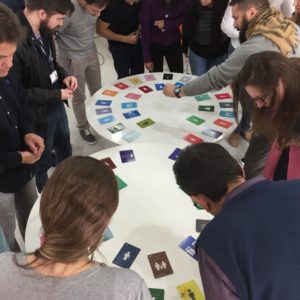 Design patterns deconstructs the myth that design projects are created by a single consciousness, the lonely designer. Every project, be that developed by a single designer or by a design team, reproduces common patterns that society at large cultivates. Card decks collect and organize design patterns with common problems and solutions in a certain design […] - Nov 22, 2018
Design patterns deconstructs the myth that design projects are created by a single consciousness, the lonely designer. Every project, be that developed by a single designer or by a design team, reproduces common patterns that society at large cultivates. Card decks collect and organize design patterns with common problems and solutions in a certain design […] - Nov 22, 2018 -
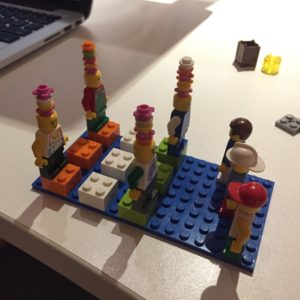 Lego is a great tool to build early prototypes of games and apps. I like. to stimulate students to supplement talking with making to increase shared understanding. Physical prototypes are quicker to build together in a team and can be used to test if ideas work in the real world. In this video, participants learn […] - Nov 22, 2018
Lego is a great tool to build early prototypes of games and apps. I like. to stimulate students to supplement talking with making to increase shared understanding. Physical prototypes are quicker to build together in a team and can be used to test if ideas work in the real world. In this video, participants learn […] - Nov 22, 2018 -

Pattern-based collaborative design with cards deck
Abstract: At PUCPR’s Academy we offer students a handful of special card decks to help them learn about the possibilities for design. There is a deck on business models, another on user interface, a third on human values, and the collection is always growing. In this hands-on session, we will demonstrate how we let students […] - Nov 22, 2018 -
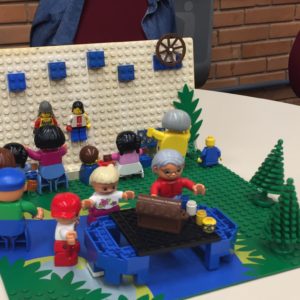 The Experience Map is an abstract representation which might not be understood by stakeholders who are responsible for shaping that experience. Since their participation is essential to stage the experience, I developed a Tangible Experience Model with uses Lego pieces to represent the relationships between people, things, spaces, and activities. Since the model’s meaning relies […] - Nov 4, 2018
The Experience Map is an abstract representation which might not be understood by stakeholders who are responsible for shaping that experience. Since their participation is essential to stage the experience, I developed a Tangible Experience Model with uses Lego pieces to represent the relationships between people, things, spaces, and activities. Since the model’s meaning relies […] - Nov 4, 2018 -

Problem Solution Problem (PSP)
The Problem Solution Problem (PSP, also known as PS³) game, developed by Frederick van Amstel and Guilherme Silveira is designed to explore and address collective creativity within the context of problem-solving. - Nov 1, 2018 -
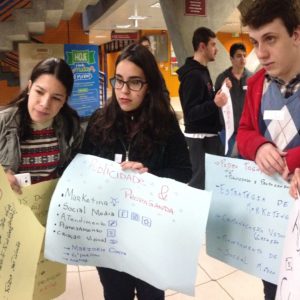 Idea Market is a design game developed to facilitate the pitching and development of new business ideas, while encouraging the formation of partnerships in entrepreneurship programs. The game simulates the dynamics of a startup ecosystem, where participants play both entrepreneurial and investor roles. Each player begins with an individual idea, sketched on paper, and progresses […] - Nov 1, 2018
Idea Market is a design game developed to facilitate the pitching and development of new business ideas, while encouraging the formation of partnerships in entrepreneurship programs. The game simulates the dynamics of a startup ecosystem, where participants play both entrepreneurial and investor roles. Each player begins with an individual idea, sketched on paper, and progresses […] - Nov 1, 2018 -
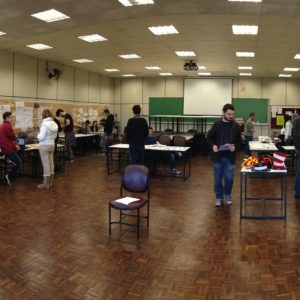
Classroom-to-Studio Transformation
I like to teach through developing projects as done in design studios. Most of the times, students need to adapt regular classrooms to work like design studios. I encourage them to appropriate the classroom space in any way that is better to support their creative activities. Along the years, we learnt together many ways to […] - Nov 1, 2018 -
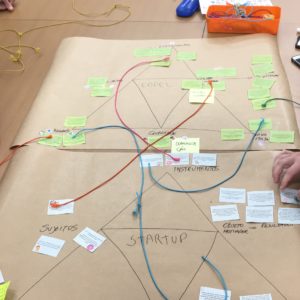 Change Laboratory is a method developed by CRADLE to help organizations change routines, deal with conflicts, and create new ideas through a participatory approach. The method consists of three different moments: 1) presenting contradictions found through ethnographic research in the organization; 2) analyzing the systemic nature of these contradictions through organizational models; 3) generating new […] - Nov 1, 2018
Change Laboratory is a method developed by CRADLE to help organizations change routines, deal with conflicts, and create new ideas through a participatory approach. The method consists of three different moments: 1) presenting contradictions found through ethnographic research in the organization; 2) analyzing the systemic nature of these contradictions through organizational models; 3) generating new […] - Nov 1, 2018 -
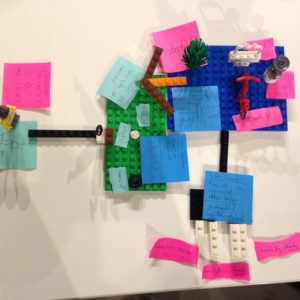 Unified Modeling Language (UML) is a set of standard diagrams and notations for creating software. We created at PUPCR a physical version of these diagrams with Lego to enable the participation of designers, clients, and users in software architecture and modeling activities. The concrete representations help the participants understand and make good use of software […] - Nov 1, 2018
Unified Modeling Language (UML) is a set of standard diagrams and notations for creating software. We created at PUPCR a physical version of these diagrams with Lego to enable the participation of designers, clients, and users in software architecture and modeling activities. The concrete representations help the participants understand and make good use of software […] - Nov 1, 2018 -
 Improvised Videos are short films recorded with smartphones to support a codesign process. They represent everyday scenarios where the design object plays a protagonist role. The interaction with the design object is depicted through variegated film and theater techniques such as enactment, role playing, props, puppets, cuts, and transitions. The main advantage of using video […] - Nov 1, 2018
Improvised Videos are short films recorded with smartphones to support a codesign process. They represent everyday scenarios where the design object plays a protagonist role. The interaction with the design object is depicted through variegated film and theater techniques such as enactment, role playing, props, puppets, cuts, and transitions. The main advantage of using video […] - Nov 1, 2018
Frederick van Amstel
Design researcher & educator